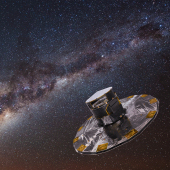ESA Science & Technology - News Archive
News archive
News archive
Find below an outline timeline for the launch of Gaia on 19 December 2013. See notes below table for details. All times subject to change. Follow launch live via ESA TV, starting 08:50 GMT (09:50 CET).
Published: 18 December 2013
ESA's Gaia mission to survey a billion stars is 'go' for launch. The satellite has passed its final checks and is ready to be launched tomorrow from Europe's spaceport in Kourou.
Published: 18 December 2013
The NASA/ESA Hubble Space Telescope has observed the variable star RS Puppis over a period of five weeks, showing the star growing brighter and dimmer as it pulsates. These pulsations have created a stunning example of a phenomenon known as a light echo, where light appears to reverberate through the murky environment around the star.
Published: 17 December 2013
ESA's billion-star surveyor Gaia, less than a week from launch, is now tucked up inside the fairing that will protect it during the first few minutes of ascent into space.
Published: 13 December 2013
Using ESA's Herschel Space Observatory, a team of astronomers has found first evidence of a noble-gas based molecule in space. A compound of argon, the molecule was detected in the gaseous filaments of the Crab Nebula, one of the most famous supernova remnants in our Galaxy.
Published: 12 December 2013
Astronomers looking at the radioactive afterglow of supernovae with ESA's INTEGRAL mission have revealed that the remains of stellar explosions power their way through the Milky Way much faster than stars and most of the Galaxy's gas.
Published: 19 November 2013
The NASA/ESA Hubble Space Telescope has captured the best ever image of the globular cluster Messier 15, a gathering of very old stars that orbits the centre of the Milky Way. This glittering cluster contains over 100 000 stars, and could also hide a rare type of black hole at its centre.
Published: 14 November 2013
Astronomers studying a black hole in our Galaxy with ESA's XMM-Newton observatory have made a surprising discovery about the cocktail of particles that are ejected from its surroundings.
Published: 13 November 2013
Updated 22 November 2013: Arianespace have announced that Gaia is scheduled to launch on 19 December 2013 at 09:12:18 UTC.
Published: 23 October 2013
ESA's Planck space telescope has been turned off after nearly 4.5 years soaking up the relic radiation from the Big Bang and studying the evolution of stars and galaxies throughout the Universe's history.
Published: 23 October 2013
Due to recently-discovered technical issues, ESA has decided to perform additional verifications on its Gaia satellite, and therefore we have requested that Arianespace postpone the Gaia launch, currently scheduled for November 20, 2013. A new launch date will be announced as soon as the availability of the satellite is confirmed.
Published: 22 October 2013
ESA's billion-star surveyor Gaia will be launched from Europe's spaceport in Kourou on 20 November to begin a five-year mission to map the stars with unprecedented precision.
Published: 21 October 2013
From the tiniest fraction of a second after the Big Bang to the evolution of stars and galaxies over 13.8 billion years, ESA's Planck space telescope has provided new insight into the history of our Universe. Although science observations are now complete, the legacy of the Planck mission lives on.
Published: 18 October 2013
An international team of astronomers has found the most distant gravitational lens yet - a galaxy that, as predicted by Albert Einstein's general theory of relativity, deflects and intensifies the light of an even more distant object.
Published: 17 October 2013
The beautiful, petal-like shells of galaxy PGC 6240 are captured here in intricate detail by the Hubble Space Telescope, set against a sky full of distant background galaxies.
Published: 10 October 2013
Cosmologists have achieved a first detection of the long-sought B-modes in the polarised Cosmic Microwave Background. The result is based on the combination of data from the South Pole Telescope and ESA's Herschel Space Observatory. This detection is a milestone along the way to the possible discovery of gravitational waves produced in the very...
Published: 1 October 2013
For the first time, astronomers have caught a pulsar in a crucial transitional phase that explains the origin of the mysterious millisecond pulsars. The discovery was made possible by the coordinated efforts of ESA's two missions that scan the high-energy sky: INTEGRAL and XMM-Newton.
Published: 25 September 2013
For the first time, astronomers have caught a pulsar in a crucial transitional phase that explains the origin of the mysterious millisecond pulsars. The discovery was made possible by the coordinated efforts of ESA's two missions that scan the high-energy sky: INTEGRAL and XMM-Newton.
Published: 25 September 2013
This Announcement of Opportunity solicits proposals for data rights on targets contained within the previously approved AO-11 observing programmes. The deadline for receipt of proposals is Friday, 4 October 2013, 14:00 CEST.
Published: 25 September 2013
This new image from Hubble is one of the best ever views of the massive galaxy cluster Abell 1689, and shows the phenomenon of gravitational lensing with unprecedented clarity.
Published: 12 September 2013
—
20 Items per Page




















